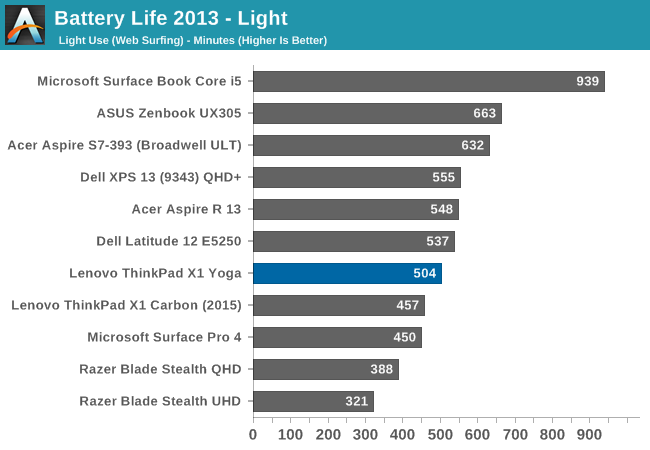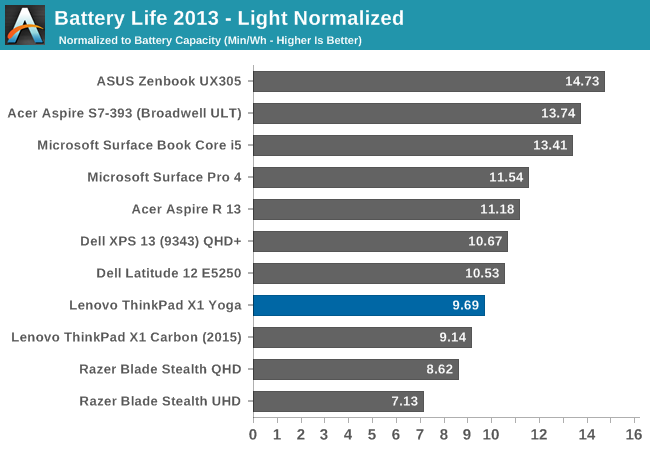The Lenovo ThinkPad X1 Yoga Review: OLED and LCD Tested
by Brett Howse & Brandon Chester on September 29, 2016 11:30 AM ESTBattery Life
For some people, performance is king, and others like a great design. Some crave great displays and some love the flexibility of a convertible device. The one thing everyone can pretty much agree on is that the battery life of a mobile device is important. Over the last couple of years, the increases in battery life due to hardware and software changes has been pretty dramatic. Notebooks that used to last an hour or two can now make it a whole working day, and others have exploited new power paradigms to rule the roost. Processors, displays, storage, and wireless cards are all more efficient than before, and even battery capacity has increased quite a bit. Despite the thin and light convertible design, Lenovo has managed to squeeze a 52 Wh battery inside the X1 Yoga. Battery capacity seems to be a moving target, with every generation seemingly increasing in size.
It is worth noting that initially there were some issues testing battery life due to the Windows 10 Anniversary Update. The method in which Edge was invoked in our tests raised some issues with Edge crashing. This gave me the chance to implement a new battery life test that I’ve wanted to do for a while. For now, the existing 2013 Light test will be maintained, although for 2016 it is just too light, as you’ll see. Going forward, the same test we utilize for our smartphones and tablets will be used. This test is noticeably heavier on the CPU and gives a better angle for real-world results.
2013 Battery Life Light

Coming in at 504 minutes, or almost 8.5 hours, the X1 Yoga with the higher resolution display is middle of the road in the light test. It does outlast the 2015 X1 Carbon by about three quarters of an hour, and the specifications are pretty similar, meaning there is improvement in the design.
2016 Web Battery Life (The New Test, starting with this review)
Since this is a new test, it has only been run on the X1 Yoga, but we were able to run it on the OLED version as well. OLED has a power advantage when displaying dark images, since it only uses power to create light. In movies and such, it has proven to be a great advantage for consuming content. But there is a power penalty for OLED when doing many typical office tasks, such as spreadsheets, documents, and web browsing, since all of these activities tend to emphasize white backgrounds (in typical Windows OS environments at least). Web browsing has a pretty high average picture level (APL) for white, and as such there is a penalty for this on OLED.

On our more difficult web browsing test, the OLED version achieved 3h39 for battery life, compared to 6h11 on the LCD model. Both have the same resolution and hardware (aside from SATA vs NVMe), so most of the delta should come down to the display. The OLED model had 41% less battery life than the LCD model in this test, which, although one of the worst case scenarios for OLED, is also something that a majority of people will use quite a bit. Although OLED has some amazing gamut and contrast, in our new test it can’t touch an LCD for power efficiency when doing typical office tasks.
Normalized Results
Removing the battery size from the equation allows an equal-footing display of platform efficiency. Some laptops have large batteries but only use that to mask power draw issues, while others can make a smaller battery last for a lot longer.

The X1 Yoga LCD model is not the most power efficient laptop around, with a normalized result on our light test of under ten. It is a minor improvement on the X1 Carbon from 2015, but an improvement nonetheless.

On the 2016 test since we just have the two results, it is difficult to draw much of a comparison at this time.
Charge Time
The other side of mobility is charge time. Even with a device that has a low battery life, being able to top up quickly can help mitigate that.

Lenovo has tended to do very well on this test, and the X1 Yoga is the fastest charging laptop tested yet. Zero to 100% in less than two hours is very good. It is helped quite a bit by the inclusion of a 65-Watt AC adapter, which is quite a bit larger than what most Ultrabooks ship with.










84 Comments
View All Comments
yomamafor1 - Friday, September 30, 2016 - link
I mean, it's not like Lenovo did make a P40 specifically for this purpose.....LordOfTheBoired - Saturday, October 1, 2016 - link
Touche. Just saying... ddriver isn't exactly what I'd call the most qualified person to make that call.Ej24 - Thursday, September 29, 2016 - link
Lenovo never puts iris graphics in anything. It drives me nuts. Been waiting for years for an ultrabook from them with iris graphics. Dell xps 13 finally has a 15w cpu with iris, and some Asus ultrabooks have 28w cpus with iris.Ro_Ja - Thursday, September 29, 2016 - link
They should've atleast put in a Skylake processor with HD 540 in it.arsjum - Thursday, September 29, 2016 - link
The second revision of Yoga 900 as well as IdeaPad 710s are both equipped with Skylake Iris graphics.spikebike - Friday, September 30, 2016 - link
Try the Lenovo Ideapad 721s, has the iris graphics. Sadly the disabled the AHCI interface and require some whacky "RAID" mode which is really just saying "Hey, windows, use your software raid driver". The XPS 13 does have the iris as well, but sadly it's tied to the 3200x1800 touchscreen which is shiny and halves your battery life.ajp_anton - Friday, September 30, 2016 - link
I have the 1080p non-touch version of the XPS 13, with Iris 540 graphics.Pissedoffyouth - Thursday, September 29, 2016 - link
What possibly could you be doing on an ultrabook that you need Iris graphics? I'd rather have a CPU-heavy focused TDP that shitty CPU and a bit GPUCliff34 - Thursday, September 29, 2016 - link
The only CPU with Iris GPU are HQ processors. HQ processor always perform better than U processor. For me, the two possible reasons why they don't use HQ processors are either they want a CPU that doesn't generate too much heat and/or force consumers to buy a laptop with its own discrete graphic card (and spend more money).arsjum - Thursday, September 29, 2016 - link
Not true at all. U-series CPUs can come with HD 540 and HD 550 Iris graphics.